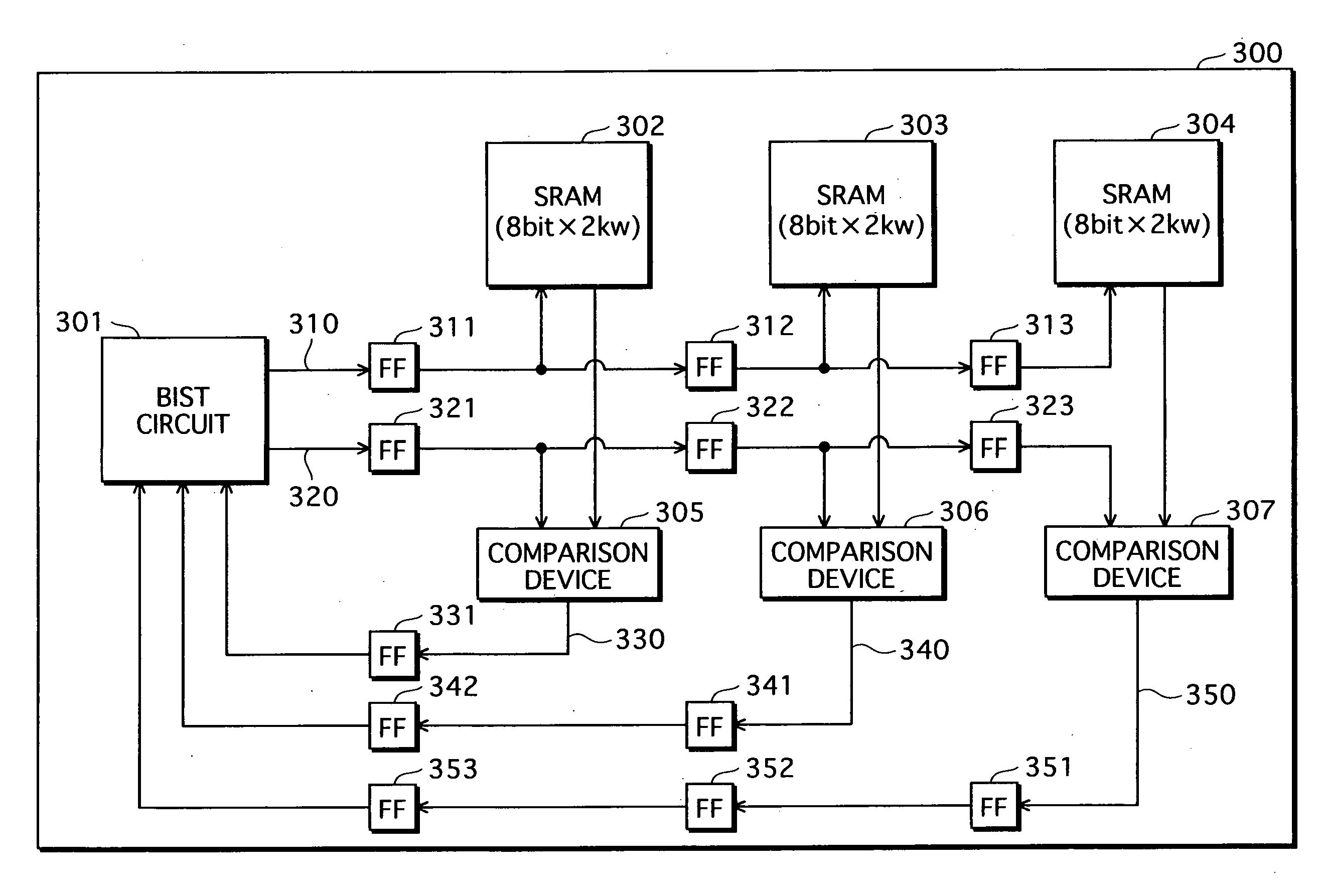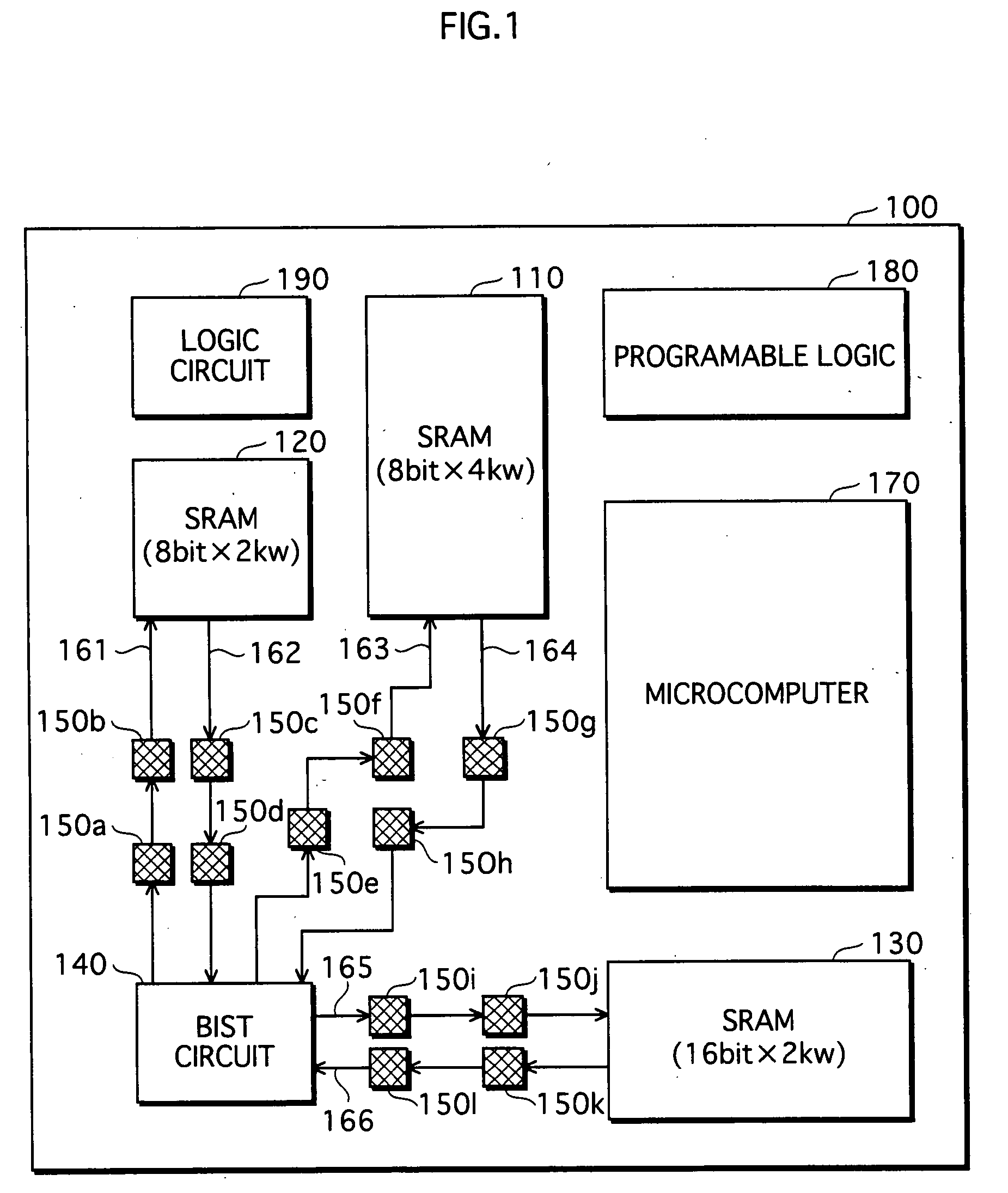Semiconductor integrated circuit and bist circuit design method
a semiconductor integrated circuit and design method technology, applied in error detection/correction, instruments, measurement devices, etc., can solve the problems of difficult to conduct a sufficient test for the semiconductor integrated circuit from outside, large overhead area of the circuit, and small number of external input/output terminals, etc., to achieve the effect of improving the test speed of the bis
- Summary
- Abstract
- Description
- Claims
- Application Information
AI Technical Summary
Benefits of technology
Problems solved by technology
Method used
Image
Examples
first embodiment
[0038]FIG. 1 shows a layout of an LSI 100 according to the present invention.
[0039]The LSI 100 is a system LSI that includes circuit blocks formed on a semiconductor substrate, namely memories 110, 120 and 130, a BIST circuit 140, registers 150a-150l, a microcomputer 170, a programmable logic circuit 180 and a-logic circuit 190. Note that the LSI 100 may include other circuits in addition to the circuits mentioned above.
[0040]The memory BIST, which is the subject matter of the present invention, is performed on the memories 110, 120 and 130. The memory 110 is an 8-bit×4K-word memory circuit. The memory 120 is an 8-bit×2K-word memory circuit. The memory 130 is a 16-bit×2K-word memory circuit. In the memory BIST, each memory circuit writes test data at a specified address upon receiving a test vector, and reads test data at a specified address upon receiving a read command. Note that one clock cycle (10 ns) is required for each memory circuit to perform each of a write access for writ...
second embodiment
[0069]The second embodiment explains a structure that further reduces the circuit area relating to the BIST.
[0070]FIG. 7 shows a structure relating to the BIST in an LSI 300 according to the second embodiment.
[0071]The LSI 300 includes, in addition to a BIST circuit 301 and memories 302, 303 and 304 as targets of the BIST, circuit blocks that are not illustrated, such as a microcomputer, dedicated hardware, and a programmable logic circuit.
[0072]The memories 302, 303 and 304 are memory circuits that are the same as the memories 101, 102 and 103 shown in FIG. 1, and are targets of the BIST test. Each memory circuit outputs a read data to a comparison device corresponding to the memory circuit.
[0073]In the same manner as the data generation unit 141, the BIST circuit 301 has functions of generating and outputting a test vector and a read command, outputting a random number as a comparison data, which has been used as test data in the test vector, and acquiring the comparison results o...
third embodiment
[0084]FIG. 9 shows a structure relating to the BIST in an LSI 500 according to the third embodiment.
[0085]The difference from the LSI 300 shown in FIG. 7 is that the outputs from the comparison devices 305, 306 and 307 in the LSI 500 are connected together as a serial chain.
[0086]As described above, upon receiving the read data of the corresponding memory circuit and the comparison data, each of the comparison devices 305, 306 and 307 compares whether the read data and the comparison data are identical, and outputs the comparison result. Specifically, if the pieces of data are identical, the comparison device outputs “1”, and if not, the comparison device outputs “0”.
[0087]The output from the comparison device 307 is input to a register 361, and the output from the register 361 is input to a logic circuit 365. The output from the comparison device 306 is also input to the logic circuit 364. The logic circuit 364 outputs logical multiplication of the input value. Accordingly, the log...
PUM
 Login to View More
Login to View More Abstract
Description
Claims
Application Information
 Login to View More
Login to View More - R&D
- Intellectual Property
- Life Sciences
- Materials
- Tech Scout
- Unparalleled Data Quality
- Higher Quality Content
- 60% Fewer Hallucinations
Browse by: Latest US Patents, China's latest patents, Technical Efficacy Thesaurus, Application Domain, Technology Topic, Popular Technical Reports.
© 2025 PatSnap. All rights reserved.Legal|Privacy policy|Modern Slavery Act Transparency Statement|Sitemap|About US| Contact US: help@patsnap.com



